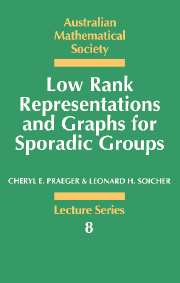3 - The Methods
Published online by Cambridge University Press: 15 September 2009
Summary
We now describe the methods used to classify the transitive representations of rank at most 5 of the sporadic almost simple groups, and to analyse their associated generalized orbital digraphs. The methods for the analysis of these digraphs via their collapsed adjacency matrices are general, and are not restricted to sporadic groups or to low rank representations.
Permutation characters
Let G be a finite group. For a permutation representation of G on a finite set Ω, the permutation character π is the map π : G → ℂ such that, for g ∈ G, π(g) is the number of points of Ω fixed by g. Now π is the character (trace map) of the natural matrix representation for G on the complex vector space ℂΩ (see for example [Isa76, p. 68]), and so π is a sum of complex irreducible characters for G. In particular the multiplicity of the trivial character 1G in π is equal to the number of orbits of G in Ω (see [Isa76, Corollary 5.15]) and in particular π is a transitive permutation character (that is, the permutation character of a transitive permutation representation) precisely when 1G has multiplicity 1 in π. In order to understand our arguments concerning permutation characters, the reader who is not familiar with the basic theory of (permutation) characters for finite groups is urged to consult the excellent reference [Isa76], especially Chapter 5.
- Type
- Chapter
- Information
- Low Rank Representations and Graphs for Sporadic Groups , pp. 19 - 28Publisher: Cambridge University PressPrint publication year: 1996

